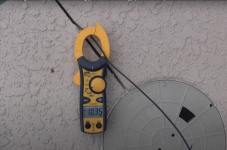The part where he drops a live wire in the pool is interesting because it shows that bonding does not make things safe.
It shows 10.35 amps of current flowing through the wire into the pool and then into the bonding grid and probably most of the current returns to the utility transformer secondary neutral through the equipment grounding conductor to the neutral bar in the house and then to the utility secondary neutral.
Even with bonding, the current flowing through the system is very high and the voltage gradients are also high.
Someone exiting the pool would be at highest risk touching a bonded handrail that was not touching the water because the human body would become the path between the water and the bonded handrail.
View attachment 357337



